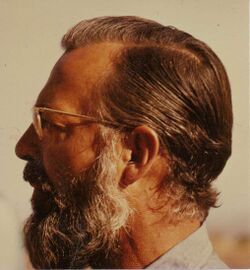Biography:John Huizinga
John Huizinga, M.D. | |
|---|---|
 | |
| Born | Amsterdam |
| Died | 28 August 2008 (aged 88) |
| Alma mater | Amsterdam University, Utrecht University |
| Scientific career | |
| Fields | Biology, human genetics, human biology, physical anthropology |
| Doctoral advisor | Arie de Froe |
| Doctoral students | Teuku Jacob |
This article is about the Dutch geneticist. For the cultural historian see Johan Huizinga.
Johan "John" Huizinga (29 June 1920 – 28 August 2008) was a Dutch academic who became professor of Human Biology at Utrecht University in the Netherlands.
Early career
After finishing medical school, John Huizinga started as assistant to A. de Froe, a physician and anatomist at Amsterdam University. To save the lives of a number of Jews during World War II, he and de Froe produced 'scientific physical proof' of their being Aryans which prevented them from being sent to Nazi concentration camps.
After the war, de Froe's very popular teaching on human variation and human evolution undoubtedly inspired John Huizinga to write his PhD thesis on the cephalo-metric relationship between first degree relatives.
After he joined the Department of Anatomy in Utrecht, Huizinga introduced modern skeletal research by publishing a series of studies on Dutch skeletal material. Meanwhile, the field became internationally well defined, and in 1952 John's inaugural lecture as university professor dealt with physical anthropology in general.
Institute of Human Biology
In 1960, John Huizinga founded in Utrecht the Institute of Human Biology. Unique was his multidisciplinary approach. A variety of subjects, both on skeletal work and on living populations, were researched by a growing number of staff, with room also for archaeological and cultural aspects of the people studied.
The well-equipped library housed an immense collection of almost all papers on the various topics of the field of those days, due to the abstracts which for years had been composed weekly – mainly during weekends – for Keesing Archives/Excerpta Medica, of which Huizinga was editor of the human genetics section.
John Huizinga actively participated in the section Human Adaptability of the International Biological Program (IBP) (1964–74). In 1975 he was one of the 30 leading anthropologists to found the European Anthropological Association (EAA). Later, he would act as its president for two years. During that time, well-known colleagues such as Phillip Tobias, G. Ainsworth Harrison, Nobel Prize winner Theodosius Dobzhansky, Ronald Singer, and John Weiner, one of the leaders of IBP, were welcome visitors to Huizinga's Institute. The Indonesian paleoanthropologist Teuku Jacob came to the Institute to write his dissertation on the Utrecht collection of Indonesian skeletal material and recently discovered Homo erectus finds.
Expeditions
For more than twenty years professor Huizinga organized annual expeditions to various areas in the West-African savanna belt south of the Sahara, to study physiological and genetic aspects of adaptation. Among its team members were Rogier Bedaux and Gerard Verschuuren. The expeditions were remarkably multidisciplinary: next to skeletal investigations, population genetics, and tests on physical fitness, also cultural aspects were studied, such as pottery and textiles.
In 1964 a weekly Dutch TV series reported how members of the expedition, including Herman Haan, were breathtakingly pulled up in an immense steel ball along the meters high, sheer cliff to the centuries-old burial sites of the since long mysteriously vanished Tellem people. Comparisons were made of the Tellem remains with the present inhabitants of the lower cliff area, the Dogon. They proved to be not related.
Further developments
Huizinga and his friend from their days at Anatomy in Amsterdam, Boy Edgar, M.D. became interested in the then hardly understood genetic background of diseases. Before genetic counselling became more popular, Edgar and Huizinga already gave advice to parents with children with extremely severe diseases. Yet later, Huizinga refused to render routine services to the university hospital for developing field genetic counselling. Thus in 1979, the Faculty of Medicine directly appointed a human geneticist – initially expected to join Huizinga's staff – at a soon blossoming new department of clinical genetics which was richly endowed with subsidies, and John Huizinga's institute was left behind.
When Professor Huizinga retired in 1986, his drastically reduced institute was closed by the university authorities for budgetary reasons—notwithstanding the fact that 21 leading professors from 10 different countries wrote letters of protest to the Royal Dutch Academy of Sciences.
Extended links
- J. Huizinga, 1920 - 2008 at the University of Amsterdam Album Academicum website
- In Memoriam of John Huizinga by Dr. Machteld Roede
- Book Review on Race Theories by Dr. Machteld Roede
- History of the Tellem Expedition
This article uses only URLs for external sources. (2021) (Learn how and when to remove this template message) |
This article does not cite any external source. HandWiki requires at least one external source. See citing external sources. (2021) (Learn how and when to remove this template message) |
 |

